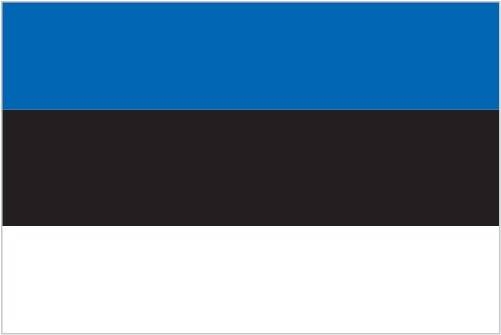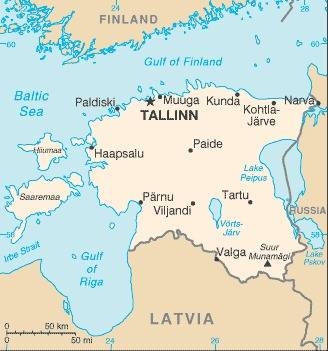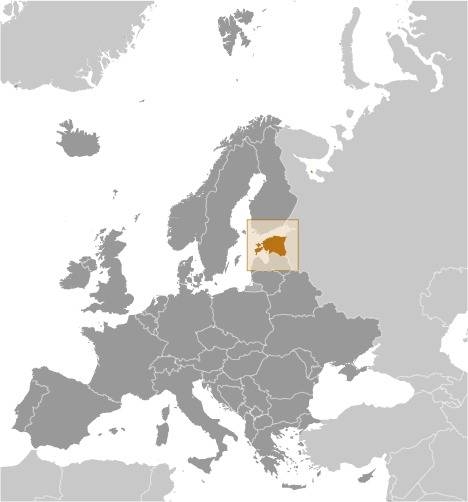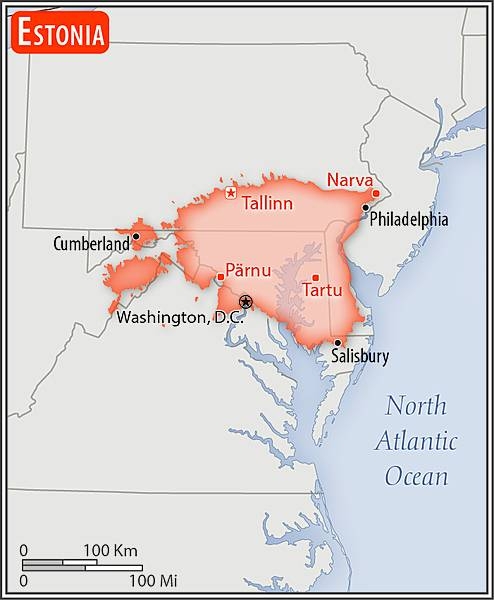Estonia
Introduction
Background
After centuries of Danish, Swedish, German, and Russian rule, Estonia attained independence in 1918. Forcibly incorporated into the USSR in 1940 - an action never recognized by the US and many other countries - it regained its freedom in 1991 with the collapse of the Soviet Union. Since the last Russian troops left in 1994, Estonia has been free to promote economic and political ties with the West. It joined both NATO and the EU in the spring of 2004, formally joined the OECD in late 2010, and adopted the euro as its official currency on 1 January 2011.
Visit the Definitions and Notes page to view a description of each topic.
Geography
Location
Eastern Europe, bordering the Baltic Sea and Gulf of Finland, between Latvia and Russia
Geographic coordinates
59 00 N, 26 00 E
Map references
Europe
Area
total: 45,228 sq km
land: 42,388 sq km
water: 2,840 sq km
note: includes 1,520 islands in the Baltic Sea
Land boundaries
total: 657 km
border countries (2): Latvia 333 km; Russia 324 km
Coastline
3,794 km
Maritime claims
territorial sea: 12 nm
exclusive economic zone: limits as agreed to by Estonia, Finland, Latvia, Sweden, and Russia
Climate
maritime; wet, moderate winters, cool summers
Terrain
marshy, lowlands; flat in the north, hilly in the south
Elevation
highest point: Suur Munamagi 318 m
lowest point: Baltic Sea 0 m
mean elevation: 61 m
Natural resources
oil shale, peat, rare earth elements, phosphorite, clay, limestone, sand, dolomite, arable land, sea mud
Land use
agricultural land: 22.2% (2018 est.)
arable land: 14.9% (2018 est.)
permanent crops: 0.1% (2018 est.)
permanent pasture: 7.2% (2018 est.)
forest: 52.1% (2018 est.)
other: 25.7% (2018 est.)
Irrigated land
20 sq km (2016)
Population distribution
a fairly even distribution throughout most of the country, with urban areas attracting larger and denser populations
Natural hazards
sometimes flooding occurs in the spring
Geography - note
the mainland terrain is flat, boggy, and partly wooded; offshore lie more than 1,500 islands
People and Society
Nationality
noun: Estonian(s)
adjective: Estonian
Ethnic groups
Estonian 68.7%, Russian 24.8%, Ukrainian 1.7%, Belarusian 1%, Finn 0.6%, other 1.6%, unspecified 1.6% (2011 est.)
Languages
Estonian (official) 68.5%, Russian 29.6%, Ukrainian 0.6%, other 1.2%, unspecified 0.1% (2011 est.)
Religions
Orthodox 16.2%, Lutheran 9.9%, other Christian (including Methodist, Seventh Day Adventist, Roman Catholic, Pentecostal) 2.2%, other 0.9%, none 54.1%, unspecified 16.7% (2011 est.)
Age structure
0-14 years: 16.22% (male 102,191/female 97,116)
15-24 years: 8.86% (male 56,484/female 52,378)
25-54 years: 40.34% (male 252,273/female 243,382)
55-64 years: 13.58% (male 76,251/female 90,576)
65 years and over: 21% (male 89,211/female 168,762) (2020 est.)
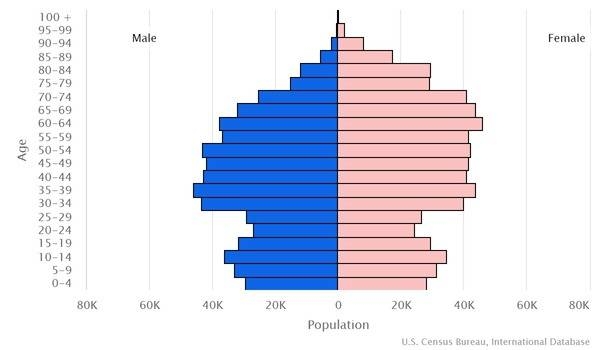
Dependency ratios
total dependency ratio: 58.3
youth dependency ratio: 26.1
elderly dependency ratio: 32.3
potential support ratio: 3.1 (2021 est.)
Median age
total: 43.7 years
male: 40.4 years
female: 47 years (2020 est.)
Population distribution
a fairly even distribution throughout most of the country, with urban areas attracting larger and denser populations
Urbanization
urban population: 69.8% of total population (2023)
rate of urbanization: -0.03% annual rate of change (2020-25 est.)
Major urban areas - population
454,000 TALLINN (capital) (2023)
Sex ratio
at birth: 1.05 male(s)/female
0-14 years: 1.05 male(s)/female
15-24 years: 1.08 male(s)/female
25-54 years: 1.05 male(s)/female
55-64 years: 0.85 male(s)/female
65 years and over: 0.42 male(s)/female
total population: 0.89 male(s)/female (2022 est.)
Mother's mean age at first birth
28.2 years (2020 est.)
Maternal mortality ratio
9 deaths/100,000 live births (2017 est.)
country comparison to the world: 147Infant mortality rate
total: 3.42 deaths/1,000 live births
male: 3.29 deaths/1,000 live births
female: 3.56 deaths/1,000 live births (2022 est.)
Life expectancy at birth
total population: 77.88 years
male: 73.25 years
female: 82.73 years (2022 est.)
Drinking water source
improved: urban: 100% of population
rural: NA
total: 99.6% of population
unimproved: urban: 0% of population
rural: NA
total: 0.4% of population (2020 est.)
Current health expenditure
6.7% of GDP (2019)
Physicians density
3.47 physicians/1,000 population (2019)
Hospital bed density
4.6 beds/1,000 population (2018)
Sanitation facility access
improved: urban: 99.8% of population
rural: 100% of population
total: 99.8% of population
unimproved: urban: 0.2% of population
rural: 0% of population
total: 0.2% of population (2020 est.)
Major infectious diseases
degree of risk: intermediate (2020)
vectorborne diseases: tickborne encephalitis
Alcohol consumption per capita
total: 11.65 liters of pure alcohol (2019 est.)
beer: 4 liters of pure alcohol (2019 est.)
wine: 1.92 liters of pure alcohol (2019 est.)
spirits: 4.6 liters of pure alcohol (2019 est.)
other alcohols: 1.13 liters of pure alcohol (2019 est.)
Tobacco use
total: 29.7% (2020 est.)
male: 36.3% (2020 est.)
female: 23% (2020 est.)
Literacy
definition: age 15 and over can read and write
total population: 99.8%
male: 99.8%
female: 99.8% (2015)
School life expectancy (primary to tertiary education)
total: 16 years
male: 15 years
female: 17 years (2020)
Youth unemployment rate (ages 15-24)
total: 16.7%
male: 18.4%
female: 15% (2021 est.)
Environment
Environment - current issues
air polluted with sulfur dioxide from oil-shale burning power plants in northeast; however, the amounts of pollutants emitted into the air have fallen dramatically and the pollution load of wastewater at purification plants has decreased substantially due to improved technology and environmental monitoring; Estonia has more than 1,400 natural and manmade lakes, the smaller of which in agricultural areas need to be monitored; coastal seawater is polluted in certain locations
Environment - international agreements
party to: Air Pollution, Air Pollution-Heavy Metals, Air Pollution-Nitrogen Oxides, Air Pollution-Persistent Organic Pollutants, Air Pollution-Sulphur 85, Air Pollution-Volatile Organic Compounds, Antarctic Treaty, Biodiversity, Climate Change, Climate Change-Kyoto Protocol, Climate Change-Paris Agreement, Comprehensive Nuclear Test Ban, Desertification, Endangered Species, Environmental Modification, Hazardous Wastes, Law of the Sea, Marine Dumping-London Protocol, Ozone Layer Protection, Ship Pollution, Tropical Timber 2006, Wetlands, Whaling
signed, but not ratified: none of the selected agreements
Air pollutants
particulate matter emissions: 6.74 micrograms per cubic meter (2016 est.)
carbon dioxide emissions: 16.59 megatons (2016 est.)
methane emissions: 0.99 megatons (2020 est.)
Climate
maritime; wet, moderate winters, cool summers
Land use
agricultural land: 22.2% (2018 est.)
arable land: 14.9% (2018 est.)
permanent crops: 0.1% (2018 est.)
permanent pasture: 7.2% (2018 est.)
forest: 52.1% (2018 est.)
other: 25.7% (2018 est.)
Urbanization
urban population: 69.8% of total population (2023)
rate of urbanization: -0.03% annual rate of change (2020-25 est.)
Revenue from forest resources
forest revenues: 0.85% of GDP (2018 est.)
country comparison to the world: 55Major infectious diseases
degree of risk: intermediate (2020)
vectorborne diseases: tickborne encephalitis
Waste and recycling
municipal solid waste generated annually: 473,000 tons (2015 est.)
municipal solid waste recycled annually: 117,020 tons (2015 est.)
percent of municipal solid waste recycled: 24.7% (2015 est.)
Total water withdrawal
municipal: 59.4 million cubic meters (2017 est.)
industrial: 1.721 billion cubic meters (2017 est.)
agricultural: 4.5 million cubic meters (2017 est.)
Total renewable water resources
12.806 billion cubic meters (2017 est.)
Government
Country name
conventional long form: Republic of Estonia
conventional short form: Estonia
local long form: Eesti Vabariik
local short form: Eesti
former: Estonian Soviet Socialist Republic (while occupied by the USSR)
etymology: the country name may derive from the Aesti, an ancient people who lived along the eastern Baltic Sea in the first centuries A.D.
Government type
parliamentary republic
Capital
name: Tallinn
geographic coordinates: 59 26 N, 24 43 E
time difference: UTC+2 (7 hours ahead of Washington, DC, during Standard Time)
daylight saving time: +1hr, begins last Sunday in March; ends last Sunday in October
etymology: the Estonian name is generally believed to be derived from "Taani-linn" (originally meaning "Danish castle", now "Danish town") after a stronghold built in the area by the Danes; it could also have come from "tali-linn" ("winter castle" or "winter town") or "talu-linn" ("home castle" or "home town")
Administrative divisions
15 urban municipalities (linnad, singular - linn), 64 rural municipalities (vallad, singular vald)
urban municipalities: Haapsalu, Keila, Kohtla-Jarve, Loksa, Maardu, Narva, Narva-Joesuu, Paide, Parnu, Rakvere, Sillamae, Tallinn, Tartu, Viljandi, Voru
rural municipalities: Alutaguse, Anija, Antsla, Elva, Haademeeste, Haljala, Harku, Hiiumaa, Jarva, Joelahtme, Jogeva, Johvi, Kadrina, Kambja, Kanepi, Kastre, Kehtna, Kihnu, Kiili, Kohila, Kose, Kuusalu, Laane-Harju, Laane-Nigula, Laaneranna, Luganuse, Luunja, Marjamaa, Muhu, Mulgi, Mustvee, Noo, Otepaa, Peipsiaare, Pohja-Parnumaa, Pohja-Sakala, Poltsamaa, Polva, Raasiku, Rae, Rakvere, Räpina, Rapla, Rouge, Ruhnu, Saarde, Saaremaa, Saku, Saue, Setomaa, Tapa, Tartu, Toila, Tori, Torva, Turi, Vaike-Maarja, Valga, Viimsi, Viljandi, Vinni, Viru-Nigula, Vormsi, Voru
Independence
24 February 1918 (from Soviet Russia); 20 August 1991 (declared from the Soviet Union); 6 September 1991 (recognized by the Soviet Union)
National holiday
Independence Day, 24 February (1918); note - 24 February 1918 was the date Estonia declared its independence from Soviet Russia and established its statehood; 20 August 1991 was the date it declared its independence from the Soviet Union restoring its statehood
Constitution
history: several previous; latest adopted 28 June 1992, entered into force 3 July 1992
amendments: proposed by at least one-fifth of Parliament members or by the president of the republic; passage requires three readings of the proposed amendment and a simple majority vote in two successive memberships of Parliament; passage of amendments to the "General Provisions" and "Amendment of the Constitution" chapters requires at least three-fifths majority vote by Parliament to conduct a referendum and majority vote in a referendum; amended several times, last in 2015
Legal system
civil law system
International law organization participation
accepts compulsory ICJ jurisdiction with reservations; accepts ICCt jurisdiction
Citizenship
citizenship by birth: no
citizenship by descent only: at least one parent must be a citizen of Estonia
dual citizenship recognized: no
residency requirement for naturalization: 5 years
Suffrage
18 years of age; universal; age 16 for local elections
Executive branch
chief of state: President Alar KARIS (since 11 October 2021)
head of government: Prime Minister Kaja KALLAS (since 26 January 2021)
cabinet: Cabinet appointed by the prime minister, approved by Parliament
elections/appointments:
president indirectly elected by Parliament for a 5-year term (eligible for a second term); if a candidate does not secure two thirds of the votes after 3 rounds of balloting, then an electoral college consisting of Parliament members and local council members elects the president, choosing between the 2 candidates with the highest number of votes; election last held on 30-31 August 2021 (next to be held in 2026); in a first round of voting on 30 August, parliament failed to elect a president; in a second round on 31 August, the sole candidate, Alar KARIS, received 72 votes of 101 votes (there were 8 blank votes and 21 electors not present); prime minister nominated by the president and approved by Parliament
election results:
2021: Alar KARIS elected president; parliamentary vote Alar KARIS (independent) 72 of 101 votes; KALLAS is Estonia's first female prime minister
2016: Kersti KALJULAID is indirectly elected president with 81 of 98 votes in parliament (17 ballots blank). She is sworn in on October 10 as the first female head of state of Estonia.
Legislative branch
description: unicameral Parliament or Riigikogu (101 seats; members directly elected in multi-seat constituencies by open- list proportional representation vote to serve 4-year terms)
elections: last held on 3 March 2019 (next to be held in March 2023)
election results: percent of vote by party - RE 28.9%, K 23.1%, EKRE 17.8%, Pro Patria 11.4%, SDE 9.8%, other 9%; seats by party - RE 34, K 26, EKRE 19, Pro Patria 12, SDE 10; composition - men 75, women 26, percent of women 25.7%
Judicial branch
highest court(s): Supreme Court (consists of 19 justices, including the chief justice, and organized into civil, criminal, administrative, and constitutional review chambers)
judge selection and term of office: the chief justice is proposed by the president of the republic and appointed by the Riigikogu; other justices proposed by the chief justice and appointed by the Riigikogu; justices appointed for life
subordinate courts: circuit (appellate) courts; administrative, county, city, and specialized courts
Political parties and leaders
Center Party of Estonia (Keskerakond) or K [Juri RATAS]
Estonia 200 [Kristina KALLAS]
Estonian Conservative People's Party (Konservatiivne Rahvaerakond) or EKRE [Martin HELME]
Estonian Reform Party (Reformierakond) or RE [Kaja KALLAS]
Pro Patria (Isamaa) [Helir-Valdor SEEDER]
Social Democratic Party or SDE [Lauri LAANEMETS]
International organization participation
Australia Group, BA, BIS, CBSS, CD, CE, EAPC, EBRD, ECB, EIB, EMU, ESA (cooperating state), EU, FAO, IAEA, IBRD, ICAO, ICC (national committees), ICCt, ICRM, IDA, IEA, IFAD, IFC, IFRCS, IHO, ILO, IMF, IMO, Interpol, IOC, IOM, IPU, ISO, ITSO, ITU, ITUC (NGOs), MIGA, MINUSMA, NATO, NIB, NSG, OAS (observer), OECD, OIF (observer), OPCW, OSCE, PCA, Schengen Convention, UN, UNCTAD, UNESCO, UNHCR, UNTSO, UPU, Wassenaar Arrangement, WCO, WHO, WIPO, WMO, WTO
Diplomatic representation in the US
chief of mission: Ambassador Kristjan PRIKK (since 7 July 2021)
chancery: 1990 K Street NW, Washington, DC 20006
telephone: [1] (202) 588-0101
FAX: [1] (202) 588-0108
email address and website:
Embassy.Washington@mfa.ee
https://washington.mfa.ee/
consulate(s) general: New York, San Francisco
Diplomatic representation from the US
chief of mission: Ambassador (vacant); Charge d'Affaires Brian RORAFF (since July 2019)
embassy: Kentmanni 20, 15099 Tallinn
mailing address: 4530 Tallinn Place, Washington DC 20521-4530
telephone: [372] 668-8100
FAX: [372] 668-8265
email address and website:
acstallinn@state.gov
https://ee.usembassy.gov/
Flag description
three equal horizontal bands of blue (top), black, and white; various interpretations are linked to the flag colors; blue represents faith, loyalty, and devotion, while also reminiscent of the sky, sea, and lakes of the country; black symbolizes the soil of the country and the dark past and suffering endured by the Estonian people; white refers to the striving towards enlightenment and virtue, and is the color of birch bark and snow, as well as summer nights illuminated by the midnight sun
National symbol(s)
barn swallow, cornflower; national colors: blue, black, white
National anthem
name: "Mu isamaa, mu onn ja room" (My Native Land, My Pride and Joy)
lyrics/music: Johann Voldemar JANNSEN/Fredrik PACIUS
note: adopted 1920, though banned between 1940 and 1990 under Soviet occupation; the anthem, used in Estonia since 1869, shares the same melody as Finland's but has different lyrics
National heritage
total World Heritage Sites: 2 (both cultural)
selected World Heritage Site locales: Historic Center (Old Town) of Tallinn; Struve Geodetic Arc
Economy
Economic overview
Estonia, a member of the EU since 2004 and the euro zone since 2011, has a modern market-based economy and one of the higher per capita income levels in Central Europe and the Baltic region, but its economy is highly dependent on trade, leaving it vulnerable to external shocks. Estonia's successive governments have pursued a free market, pro-business economic agenda, and sound fiscal policies that have resulted in balanced budgets and the lowest debt-to-GDP ratio in the EU.
The economy benefits from strong electronics and telecommunications sectors and strong trade ties with Finland, Sweden, Germany, and Russia. The economy’s 4.9% GDP growth in 2017 was the fastest in the past six years, leaving the Estonian economy in its best position since the financial crisis 10 years ago. For the first time in many years, labor productivity increased faster than labor costs in 2017. Inflation also rose in 2017 to 3.5% alongside increased global prices for food and energy, which make up a large share of Estonia’s consumption.
Estonia is challenged by a shortage of labor, both skilled and unskilled, although the government has amended its immigration law to allow easier hiring of highly qualified foreign workers, and wage growth that outpaces productivity gains. The government is also pursuing efforts to boost productivity growth with a focus on innovations that emphasize technology start-ups and e-commerce.
Real GDP (purchasing power parity)
$47.44 billion (2020 est.)
$48.87 billion (2019 est.)
$46.54 billion (2018 est.)
note: data are in 2017 dollars
Real GDP growth rate
5% (2019 est.)
4.36% (2018 est.)
5.51% (2017 est.)
Real GDP per capita
$35,600 (2020 est.)
$36,800 (2019 est.)
$35,200 (2018 est.)
note: data are in 2017 dollars
GDP (official exchange rate)
$31.461 billion (2019 est.)
Inflation rate (consumer prices)
2.2% (2019 est.)
3.4% (2018 est.)
3.4% (2017 est.)
Credit ratings
Fitch rating: AA- (2018)
Moody's rating: A1 (2002)
Standard & Poors rating: AA- (2011)
note: The year refers to the year in which the current credit rating was first obtained.
GDP - composition, by sector of origin
agriculture: 2.8% (2017 est.)
industry: 29.2% (2017 est.)
services: 68.1% (2017 est.)
GDP - composition, by end use
household consumption: 50.3% (2017 est.)
government consumption: 20.4% (2017 est.)
investment in fixed capital: 24% (2017 est.)
investment in inventories: 2.2% (2017 est.)
exports of goods and services: 77.2% (2017 est.)
imports of goods and services: -74% (2017 est.)
Agricultural products
wheat, milk, barley, rapeseed, rye, oats, peas, potatoes, pork, triticale
Industries
food, engineering, electronics, wood and wood products, textiles; information technology, telecommunications
Labor force - by occupation
agriculture: 2.7%
industry: 20.5%
services: 76.8% (2017 est.)
Youth unemployment rate (ages 15-24)
total: 16.7%
male: 18.4%
female: 15% (2021 est.)
Population below poverty line
21.7% (2018 est.)
Gini Index coefficient - distribution of family income
30.4 (2017 est.)
35.6 (2014)
Household income or consumption by percentage share
lowest 10%: 2.3%
highest 10%: 25.6% (2015)
Budget
revenues: 10.37 billion (2017 est.)
expenditures: 10.44 billion (2017 est.)
Public debt
9% of GDP (2017 est.)
9.4% of GDP (2016 est.)
note: data cover general government debt and include debt instruments issued (or owned) by government entities, including sub-sectors of central government, state government, local government, and social security funds
Fiscal year
calendar year
Current account balance
$616 million (2019 est.)
$280 million (2018 est.)
Exports
$21.69 billion (2020 est.) note: data are in current year dollars
$22.94 billion (2019 est.) note: data are in current year dollars
$22.69 billion (2018 est.) note: data are in current year dollars
Exports - partners
Finland 13%, Sweden 9%, Latvia 8%, Russia 8%, United States 7%, Lithuania 6%, Germany 6% (2019)
Exports - commodities
broadcasting equipment, refined petroleum, coal tar oil, cars, prefabricated buildings (2019)
Imports
$21.73 billion (2020 est.) note: data are in current year dollars
$21.68 billion (2019 est.) note: data are in current year dollars
$21.89 billion (2018 est.) note: data are in current year dollars
Imports - partners
Russia 12%, Germany 10%, Finland 9%, Lithuania 7%, Latvia 7%, Sweden 6%, Poland 6%, China 6% (2019)
Imports - commodities
cars, refined petroleum, coal tar oil, broadcasting equipment, packaged medicines (2019)
Reserves of foreign exchange and gold
$345 million (31 December 2017 est.)
$352.2 million (31 December 2016 est.)
Debt - external
$23.944 billion (2019 est.)
$23.607 billion (2018 est.)
Exchange rates
euros (EUR) per US dollar -
0.82771 (2020 est.)
0.90338 (2019 est.)
0.87789 (2018 est.)
0.885 (2014 est.)
0.7634 (2013 est.)
Energy
Electricity access
electrification - total population: 100% (2020)
Electricity
installed generating capacity: 3.03 million kW (2020 est.)
consumption: 9.172 billion kWh (2020 est.)
exports: 3.722 billion kWh (2020 est.)
imports: 7.367 billion kWh (2020 est.)
transmission/distribution losses: 375 million kWh (2020 est.)
Electricity generation sources
fossil fuels: 55.8% of total installed capacity (2020 est.)
nuclear: 0% of total installed capacity (2020 est.)
solar: 2% of total installed capacity (2020 est.)
wind: 14.3% of total installed capacity (2020 est.)
hydroelectricity: 0.7% of total installed capacity (2020 est.)
tide and wave: 0% of total installed capacity (2020 est.)
geothermal: 0% of total installed capacity (2020 est.)
biomass and waste: 27.2% of total installed capacity (2020 est.)
Coal
production: 0 metric tons (2020 est.)
consumption: 3,000 metric tons (2020 est.)
exports: 0 metric tons (2020 est.)
imports: 3,000 metric tons (2020 est.)
proven reserves: 0 metric tons (2019 est.)
Petroleum
total petroleum production: 21,800 bbl/day (2021 est.)
refined petroleum consumption: 27,500 bbl/day (2019 est.)
crude oil and lease condensate exports: 0 bbl/day (2018 est.)
crude oil and lease condensate imports: 0 bbl/day (2018 est.)
crude oil estimated reserves: 0 barrels (2021 est.)
Natural gas
production: 0 cubic meters (2021 est.)
consumption: 417.106 million cubic meters (2020 est.)
exports: 0 cubic meters (2021 est.)
imports: 417.276 million cubic meters (2020 est.)
proven reserves: 0 cubic meters (2021 est.)
Carbon dioxide emissions
4.924 million metric tonnes of CO2 (2019 est.)
from coal and metallurgical coke: 44,000 metric tonnes of CO2 (2019 est.)
from petroleum and other liquids: 3.979 million metric tonnes of CO2 (2019 est.)
from consumed natural gas: 901,000 metric tonnes of CO2 (2019 est.)
Energy consumption per capita
76.329 million Btu/person (2019 est.)
country comparison to the world: 80Communications
Telephones - fixed lines
total subscriptions: 304,728 (2020 est.)
subscriptions per 100 inhabitants: 23 (2020 est.)
Telephones - mobile cellular
total subscriptions: 1,925,789 (2020 est.)
subscriptions per 100 inhabitants: 145 (2020 est.)
Telecommunication systems
general assessment: the competitive telecom market continues to progress with a range of regulatory measures which have enabled alternative operators to chip away at the fixed-line market share; fixed-line infrastructure upgrades have been focused on fiber, and the legacy DSL network has gradually been replaced; limited commercial 5G deployments have been made though an expansion of service availability awaits the delayed auction of spectrum in the 3.5GHz band, which is expected to be held later in 2021 (2021)
domestic: just under 23 per 100 for fixed-line subscribership and approximately 145 per 100 for mobile-cellular; substantial fiber-optic cable systems carry telephone, TV, and radio traffic in the digital mode; Internet services are widely available; schools and libraries are connected to the Internet, a large percentage of the population files income tax returns online, and online voting - in local and parliamentary elections - has climbed steadily since first being introduced in 2005; a large percent of Estonian households have broadband access (2020)
international: country code - 372; landing points for the EE-S-1, EESF-3, Baltic Sea Submarine Cable, FEC and EESF-2 fiber-optic submarine cables to other Estonia points, Finland, and Sweden; 2 international switches are located in Tallinn (2019)
note: the COVID-19 pandemic continues to have a significant impact on production and supply chains globally; since 2020, some aspects of the telecom sector have experienced a downturn, particularly in mobile device production; progress toward 5G implementation has resumed, as well as upgrades to infrastructure; consumer spending on telecom services has increased due to the surge in demand for capacity and bandwidth; the crucial nature of telecom services as a tool for work and school from home is still evident, and the spike in this area has seen growth opportunities for development of new tools and increased services
Broadcast media
the publicly owned broadcaster, Eesti Rahvusringhaaling (ERR), operates 3 TV channels and 5 radio networks; growing number of private commercial radio stations broadcasting nationally, regionally, and locally; fully transitioned to digital television in 2010; national private TV channels expanding service; a range of channels are aimed at Russian-speaking viewers; in 2016, there were 42 on-demand services available in Estonia, including 19 pay TVOD and SVOD services; roughly 85% of households accessed digital television services
Internet users
total: 1,276,521 (July 2022 est.)
percent of population: 96.1% (July 2022 est.)
Broadband - fixed subscriptions
total: 415,610 (2020 est.)
subscriptions per 100 inhabitants: 31 (2020 est.)
Transportation
National air transport system
number of registered air carriers: 3 (2020)
inventory of registered aircraft operated by air carriers: 14
annual passenger traffic on registered air carriers: 31,981 (2018)
Airports - with paved runways
total: 13
over 3,047 m: 2
2,438 to 3,047 m: 8
1,524 to 2,437 m: 2
914 to 1,523 m: 1 (2021)
Airports - with unpaved runways
total: 5
1,524 to 2,437 m: 1
914 to 1,523 m: 1
under 914 m: 3 (2021)
Heliports
1 (2021)
Pipelines
2,360 km gas (2016)
Railways
total: 2,146 km (2016)
broad gauge: 2,146 km (2016) 1.520-m and 1.524-m gauge (132 km electrified)
note: includes 1,510 km public and 636 km non-public railway
Roadways
total: 58,412 km (2011) (includes urban roads)
paved: 10,427 km (2011) (includes 115 km of expressways)
unpaved: 47,985 km (2011)
Merchant marine
total: 68
by type: general cargo 2, oil tanker 4, other 62 (2021)
Ports and terminals
major seaport(s): Kuivastu, Kunda, Muuga, Parnu Reid, Sillamae, Tallinn
Transportation - note
Estonia operates two PC 5 or 6 class icebreakers in the Baltic Sea
note - PC indicates a Polar Class vessel: PC 5 - year-round operation in medium first-year ice which may include old ice inclusions (ice thickness up to 70-120 cm); PC 6 - summer/autumn operation in medium first-year ice which may include old ice inclusions (ice thickness up to 30-70 cm)
Military and Security
Military and security forces
Estonian Defense Forces: Land Forces, Navy, Air Force, Estonian Defense League (Reserves) (2022)
Military expenditures
2.35% of GDP (2022 est.)
2.2% of GDP (2021)
2.4% of GDP (2020)
2% of GDP (2019) (approximately $850 million)
2% of GDP (2018) (approximately $800 million)
Military and security service personnel strengths
approximately 7,000 active duty personnel; approximately 15,000 Defense League (2022)
Military equipment inventories and acquisitions
the Estonian military has a limited inventory of Soviet-era and some more recently acquired modern weapons systems, largely from western European countries, particularly France and the Netherlands (2021)
Military service age and obligation
18-27 for compulsory military or governmental service for men; conscript service requirement 8-11 months depending on education; non-commissioned officers, reserve officers, and specialists serve 11 months; women can volunteer, and as of 2018 could serve in any military branch (2022)
note 1: conscripts comprise approximately 3,000-3,300 of the Estonian military's 7,000 active duty personnel and serve in all branches, except for the Air Force, which does not have conscripts; after conscript service, reservists are called up for training every 5 years; Estonia has had conscription since 1991
note 2: the Estonian Defense Forces rely largely on reservists who have completed compulsory conscription in the previous 10 years to fill out its active duty and Territorial Defense units during a crisis; a total of approximately 230,000 Estonians are enrolled in the mobilization registry
note 3: in 2020, women comprised about 10% of the full-time professional military force
Military - note
Estonia became a member of NATO in 2004
since 2017, Estonia has hosted a UK-led multi-national NATO ground force battlegroup as part of the Alliance’s Enhanced Forward Presence initiative; NATO has provided air protection for Estonia since 2004 through its Air Policing mission; NATO member countries that possess air combat capabilities voluntarily contribute to the mission on 4-month rotations; NATO fighter aircraft have been hosted at Estonia’s Ämari Air Base since 2014 (2022)
Transnational Issues
Disputes - international
Russia and Estonia in May 2005 signed a technical border agreement, but Russia in June 2005 recalled its signature after the Estonian parliament added to its domestic ratification act a historical preamble referencing the Soviet occupation and Estonia's pre-war borders under the 1920 Treaty of Tartu; Russia contends that the preamble allows Estonia to make territorial claims on Russia in the future, while Estonian officials deny that the preamble has any legal impact on the treaty text; Russia demands better treatment of the Russian-speaking population in Estonia; as a member state that forms part of the EU's external border, Estonia implements strict Schengen border rules with Russia
Refugees and internally displaced persons
refugees (country of origin): 64,593 (Ukraine) (as of 20 December 2022)
stateless persons: 71,873 (mid-year 2021); note - following independence in 1991, automatic citizenship was restricted to those who were Estonian citizens prior to the 1940 Soviet occupation and their descendants; thousands of ethnic Russians remained stateless when forced to choose between passing Estonian language and citizenship tests or applying for Russian citizenship; one reason for demurring on Estonian citizenship was to retain the right of visa-free travel to Russia; stateless residents can vote in local elections but not general elections; stateless parents who have been lawful residents of Estonia for at least five years can apply for citizenship for their children before they turn 15 years old
Illicit drugs
producer of synthetic drugs; important transshipment zone for cannabis, cocaine, opiates, and synthetic drugs since joining the European Union and the Schengen Accord; potential money laundering related to organized crime and drug trafficking is a concern, as is possible use of the gambling sector to launder funds; major use of opiates and ecstasy

